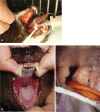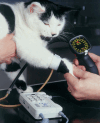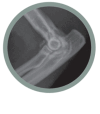ISFM and AAFP consensus guidelines: long-term use of NSAIDs in cats
- PMID: 20610311
- PMCID: PMC11148988
- DOI: 10.1016/j.jfms.2010.05.004
ISFM and AAFP consensus guidelines: long-term use of NSAIDs in cats
Abstract
NSAIDS AND CATS: Non-steroidal anti-inflammatory drugs (NSAIDs) are an important class of drug in feline medicine, having analgesic, anti-inflammatory and antipyretic activity. While most published data on their use in this species relate to short-term (often perioperative) therapy, there is increasing evidence of the value of these drugs in treating chronic pain in cats (for example, that associated with degenerative joint disease), and some NSAIDs have now become licensed for long-term use in cats in some geographies. Most of our knowledge of therapeutic mechanisms or adverse drug reactions associated with NSAIDs is extrapolated from work in other species, and there is a paucity of published data relating to cats.
Guidelines: These guidelines have been drawn together by an expert panel, which have reviewed the current literature on long-term NSAID use in cats and other species, and developed guidance on their use based on this information. The aim is to provide practical information for veterinarians to encourage appropriate NSAID therapy whenever cats will benefit from the use of these drugs.
Copyright 2010 ISFM and AAFP. Published by Elsevier Ltd. All rights reserved.
Figures












Republished in
-
Long-term use of NSAIDs in cats.Compend Contin Educ Vet. 2010 Sep;32(9):E2. Compend Contin Educ Vet. 2010. PMID: 23705186 No abstract available.
Comment in
-
NSAIDs and cats - it's been a long journey.J Feline Med Surg. 2010 Jul;12(7):519. doi: 10.1016/j.jfms.2010.05.003. J Feline Med Surg. 2010. PMID: 20610310 Free PMC article. No abstract available.
References
-
- ACVA. American College of Veterinary Anesthesiologists' position paper on the treatment of pain in animals. J Am Vet Med Assoc 1998; 213: 628–30. - PubMed
-
- Mathews K..Pain assessment and general approach to management. Vet Clin North Am Small Anim Pract 2000; 30: 729–55, v. - PubMed
-
- Slingsby L, Waterman-Pearson AE. Postoperative analgesia in the cat after ovariohysterectomy by use of carprofen, ketoprofen, meloxicam or tolfenamic acid. J Small Anim Pract 2000; 41: 447–50. - PubMed
-
- Carroll G, Howe L, Peterson K. Analgesic efficacy of preoperative administration of meloxicam or butorphanol in onychectomized cats. J Am Vet Med Assoc 2005; 226: 913–19. - PubMed
Publication types
MeSH terms
Substances
LinkOut - more resources
Full Text Sources
Medical
Miscellaneous

